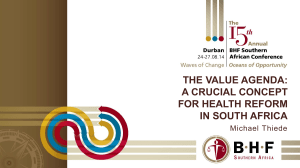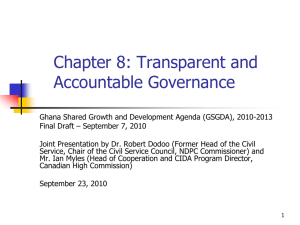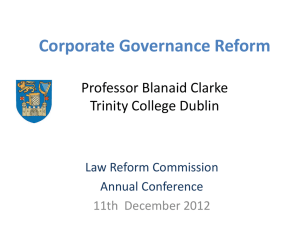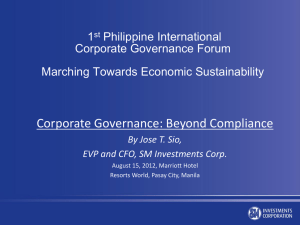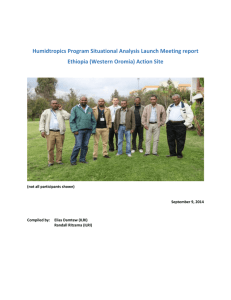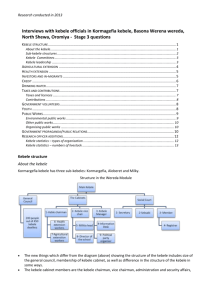Oromia Achievements by Taffesse Asfaw
advertisement
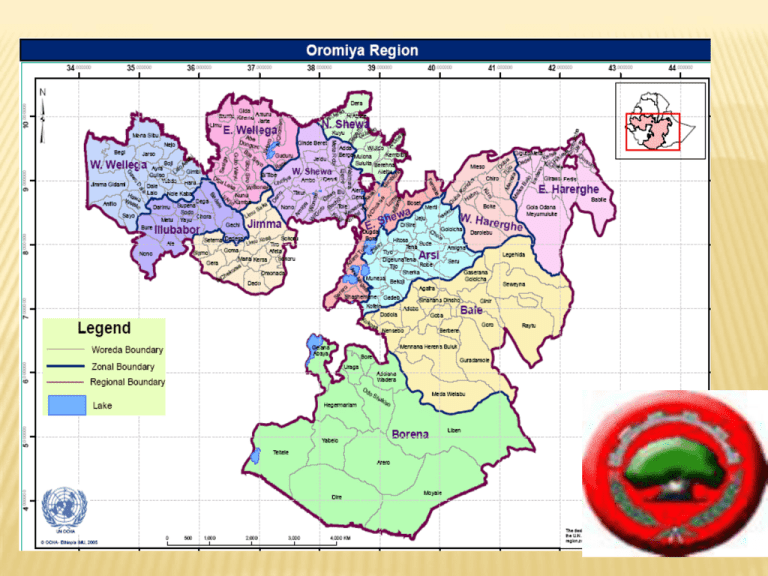
OROMIA NATIONAL REGIONAL STATE December, 2012 Harmony Hotel . Presentation On Government Policy On Accountable And Responsive Services (Ways To Improve Basic Services) ORGANIZATION OF THE PAPER Introduction Brief background Major capacity building program Sub-Programs Activities and major achievements 1. INTRODUCTION The pre-1991 strategies and approaches were characterized by the prevalence of unitary government with centralized administration, absence of devolved government, unbalanced regional development and little participation of localities and the grass roots in economic development and sharing the fruits of development. INTRODUCTION After 1991 things had been changed and the strategies and approaches were characterized by the pervalence of federal government with decentralized administration, devolved governanment. Accordingly, since 1994/95, 9 regional states and 2 city administrations were established. Moreover, since 2002 power was devolved from regional states to local governments particularly to districts. INTRODUCTION Accordingly, Regional Governments took steps to ensure accountability and transparency, establishing local government legislation which amongst other things determines clear functional responsibilities between the tiers of government. 2. BRIEF BACKGROUND: OROMIA (OCSGGB) Oromia regional state is one of the nine regional states in Ethiopia. Both in its area coverage and population, it ranks first in the country. In line with the policy and strategy formulated by the Federal government, the region has formulated its own socio-economic and development policies and strategies. Oromia regional state with its 18 zones, 265 rural districts and over 6,253 rural ‘kebeles’ (Village) in addition with 43 reform towns has given a special attention to the area where the actual economic and social programs will be implemented. BRIEF For the outcome expected from these general policies and strategies capacity building program in all sectors was the first choice. The regional government views these programs as aid for capacity building and achieving regional overall development objectives and goals. It also views capacity building program as a means of addressing and strengthening issues of governance, transparency, responsiveness and accountability in government service delivery; And to this end the regional government is being fully committed to the realization of efficient and effective systems of service provision and thereby ensure good governance at all government units level. BRIEF To that effect, Bureau of Oromia Civil Service and Good governance is vested in the major trust to coordinate the efforts and resources geared towards the implementation of public sector capacity building with the aim of bringing about institutional transformation through building capacity and system development across all sectors and levels of government bodies. This is with a view of enhancing democratic participation, promote good governance and improve service delivery by strengthening of public institutions at all levels. BRIEF Consequently, the OCSGGB has been actively involving in structural and institutional reform with clear focus on bringing sustainable development, poverty reduction, deepening democratization, promoting sound governance and empowerment based on the national strategic plan. This is due to the fact that accountable and responsive service as well as decentralization program is amongst the government’s instruments to provide opportunities to the people. 3. MAJOR CAPACITY BUILDING PROGRAM Public Sectors Capacity Building Program (PSCAP) was launched few years back from now Oromia Civil Service and Good Governance Bureau has been mandated to run the program. PROGRAM The purpose of the Regional Public Sector Capacity Building Program (PSCAP) is to build and strengthen the capacity of public sector institutions, rural and urban local governments in their efforts of discharging efficient service delivery, boosting revenue generating capacity of the government, providing transparent, and predicable judicial service, building ICT infrastructure for an efficient service delivery and renovating system of urban governance and improving urban service delivery. PROGRAM The program is expected to assist in bringing about transformation of public sector of the regional government to augment the developmental pursuits currently unfolding in the Region. Moreover, it is hopped that the program would improve local governance and citizen empowerment and substantially builds up the human capabilities for a sustained and rapid regional development. 4. SUB-PROGRAMS 1. 2. 3. 4. 5. 6. In the contexts of the foregoing developmental goals of the regional PSCAP , there are six pillars or reciprocally integrated components embodied in the program: Civil Service Reform Program, District Level Decentralization Program, Justice System Reform Program, Information and communication Technology, Tax System Reform Program, Urban Management Capacity Building Program, 4.1. CIVIL SERVICE REFORM PROGRAM, The civil service reform program as one of the six components of the regional PSCAP is intended to enhance the capacity of the civil service system. The successful implementation of this program will bring about effective, efficient, transparent, accountable, ethical and performance oriented civil service system. CSRP Moreover, this program is envisaged to enhance good governance, participatory service delivery and induce implementation of the regional government’s social and economic policies. Its general developmental impact is to bring a major difference in enhancing the capacity of the regional civil service institutions in providing adequate and quality service and enable public institutions play a pivotal role in reduction of poverty. 4.2. DISTRICT LEVEL DECENTRALIZATION PROGRAM The general objective of DLDP is to deepen the devolution of power in the 265 rural woredas of the regional government, to institutionalize decision making process at all the grass-root level with a view of enhancing democratic participation, promote good governance, improve service delivery and contribute to a sustainable development and poverty reduction. 4.3. JUSTICE SYSTEM REFORM PROGRAM Is geared towards improving the legal and judicial system. It enhances predictability and transparency of the legal and judicial system. 4.4. INFORMATION AND COMMUNICATION TECHNOLOGY The overall objectives of regional ICT is to harness the full spectrum of ICT potential for economic growth and poverty reduction, including the development of human resources, democratization and good governance on a sustainable basis. 4.5. TAX SYSTEM REFORM PROGRAM The major objective of the tax reform program is building capacity, make the tax system efficient, enhance tax payer’s compliance through tax payer education, and encouraging investment and the private sector development in the region to increase revenue for a sustainable economic development. 4.6. URBAN MANAGEMENT CAPACITY BUILDING PROGRAM The regional urban management capacity building program of the PSCAP is designed to address the capacity problems of the urban local governments of Oromia. The general goal of urban management sub-program is to facilitate the establishment of good governance and promote sustainable urban development in the region as well as enabling urban local governments of the region deliver adequate services efficiently and effectively to their residents and enable the urban sector play its due roles in the socio-economic transformation of the region. CONT’D To improve service delivery system different programs and reform tools have been implemented in all public sectors of the region; like quick wins, BPR, BSC in Civil Service Reform Program and GGP in District Level Decentralization Program CONT’D To this end, efforts have been made in establishing new system and structural arrangements for service delivery at all levels. Accordingly, information desk, customer recipient, complaint handling officer, kebele officer posts were organized in each public office down the line to the kebele level. CONT’D As already mentioned, the objective of capacity building strategy is to build a capacity that can implement development strategies. Therefore, the scope of the strategy is the scope of development strategy. CONT’D To realize this objective OCSGGB has made a lot of efforts based on the capacity building programs with respect to training, consultancy service and goods. Next is showing you the efforts made and achievements obtained out of the implementation of capacity building strategies and programs. Activities Outcome •Training (conceptual and technical) on BPR •Computer training for Regional Human Resource Experts •Training on BSC for Regional, Zonal and Woreda level leaders and experts. •Process and Result based structures are redesigned. •One stop shopping service delivery has been exercised. •Non value adding activities and handoffs are reduced. •cycle time and customer complaints are reduced. •Service delivery time improved. •Quality of work in terms of documentation improved. Strategic thinking in terms of the four perspectives. CONT’D Activities Outcome Developing BSC Performance Evaluation and Award system has been established across the region. Procurement of Goods. •Service delivery time improved. •Quality of work in terms of documentation improved. Training on leadership skills, and human resource guideline for top leaders and senior experts •Enhanced leadership capacity. •Improved service level in terms of responsiveness and efficiency at grass root level. Activities Enabling legislation for authorities has been adopted Outcome local Transparency and accountability improved Training on Gender sensitized community participation, Women and leadership, Decision making, and Women and HIV/AIDS has been provided -improved participation of women in regional and woreda council, -Participation in different development programs, leadership and decision making areas are increased. Educating Woreda Civil Service leaders and experts in different disciplines -Enhanced leadership capacity. -Improved service level in terms of responsiveness and efficiency at grass root level. Providing training on Good -Service delivery improved in terms of access, governance package for public responsiveness and quality. institutions and different community -The community started to exercise its right. groups at district and kebele level. CONT’D Activities outcome Good governance package, service provision formats, kebele manager’s working manuals, and minimum service standard and performance indicator manual had been printed and distributed Service delivery improved in terms of access, responsiveness, transparency, accountability and quality. Information desk and complaint handling Improved transparency and officers, kebele supervision and inspection accountability team, and kebele managers has been placed Computers and reference books for Improved quality and efficiency of disadvantaged woreda and lead institutions operations. has been purchased and distributed MAJOR ACTIVITIES AND OUTPUTS Various capacity building training for members of the Caffee, Woreda Councils, Town Councils & Kebele councils. Pre-duty training for new recruits of the sector, On job long term training for judges, prosecutors, professionals and law enforcement institutions communities. Community policing board were established in 5766 kebeles. The Supreme Court, Higher Courts and Woreda Courts use color coded filing system and automated court case mgt is functioning whereas Sound recorder is available at the Supreme Court and Higher Courts. OUTCOMES Improvement of oversight & control over the Executives & Judiciary in a way that ensure check & balance; Justice Organs service delivery in terms of efficiency, quality and accessibility and increased public confidence in the institutions; Participation of the Public in exposing the unjust acts increased. Data management system & utilization of technology of justice organs improved, Enhanced crime prevention, investigation & prosecution; Improved treatment of prisoners & reintegration of offenders in to the society after released; JUSTICE INSTITUTIONS OUTCOME Institution Indicator 1997 2004 0.2 0.09 Clearance Rate 100.4% 102.4% Congestion Rate 1.2 1.09 83.6% 92.09% Attrition rate at regional & zonal level - 80% Attrition rate at District level - 100% Convection Rate 69% 86% Courts case Backlog Performance Prosecutor OUTCOME OF REGIONAL COURT Description Court proceeding Court Cassation Appeal Application Document assessment Before It takes 151 days 90 days 30 days 2days 15 days After 2 days 10 days 2days 30 minutes 20 minute 3.5. COST-BENEFIT ANALYSIS ON COURT JUDGEMENT IN TWO CENTERS Time used for Court Judge No. of No. of Reduced the cases(in Hr) expense Center Files case Seen owners Southern Center (Shashamane) 357 700 84.45 133,870.00 Western Center (Nakemte) 526 1324 26.25 321,896.00 883 2024 111.10 455,7663.0 0 Total Court judge through Video Conferencing 1. ICT Human Resources Development and Training OUTPUT 2410 (M=2307, F= 103) IT professionals & Woreda Net operators was trained on Networking Security, Programming Language skills, IT equipment Maintenance 325 (M=280 F=45) Woreda Net operators selected from all woreda were trained on school net device maintenance 43,428 (M=37,123, F= 6,305) civil servant were trained on Basic Computer Applications. Outcomes Civil Servants at all level currently prefer to use computers for their daily activities due to this efficient & effective services improved ICT professions bring changes in Managing, handle, maintain, support and deliver the developed MIS to the end users satisfaction. Extend developed applications for additional functionalities and exercise in-house software development. Design, Install, configure, troubleshoot and maintain the region wide network architecture IT equipment maintenance were started at zone, and District level and maintenance expense is totally reduced Effective & efficient service delivery and good governance achieved 2. Network Expansion. OUTPUT 43 Regional Sector Bureaus were connected with WoredaNet facilities. 197 Rural Districts were connected and 69 newly emerged Districts are on process to connect All sector bureaus branches at all zone & District level near to the Woredanet facilities was connected and started to share data and Information over the facilities. 6 ICT training centers were connected and sharing educational & other resources from Regional Data warehouse. 6 Community Information Centers were connected to provide free information (Internet and other services) for the communities. CONT… Outcomes File & Data sharing over the network facilities increased so that expenses were reduced. Citizen get access to information service and started searching competitive current market price Citizen have access to choose best technology that increase their productivities. Sharing ideas through e-mail was increasing in urban areas 3. MIS SOFTWARE APPLICATION DEVELOPMENT OUTPUT 6 Bureaus MIS were developed by PSCAP-ICT Budget 14 sector bureaus MIS development is at final stage 2 ready made application were customized for regional needs. 2 application software were developed in house by IT experts Outcome of MIS application. Oromia Gov. Communication Affairs Bureau MIS Information access were established, and disseminated to the customer on appropriate time, efficiently & effectively Cost and time of collecting news from different sites (rural remote, urban…) is totally reduced Effective & efficient online information access and dissemination achieved COST BENEFIT ANALYSIS ON OROMIA GOV. COMMUNICATION AFFAIRS BUREAU MIS Resource Usage per month at Region, Zonal & Woreda level Description Activities News Preparation Article preparation Advertisement Claim/Opinion Plan & Report Expense/month Fax & Phone Paper usage consumption Video cassette consumption 63,480 4,860 228480 3,720 3,200 15,360 85,760 752 1,920 1,596 1984 11,112 228,480 133,344 228,480 - Total (Birr) 296,820 4,472 5,120 16,956 1,984 325,352 Expense/year 1,029,120 1,390,944 4 . ICT SERVICE DELIVERY OUTPUT Video Conferencing services > 40,000 regional, zonal, District and municipality top- and mid-level managers trained on good governance package through video conferences Mail services provided for all civil servants at regional level bureaus Outcomes from ICT service delivery. Effective and efficient service delivery improved Good governance is practiced Customer satisfaction increased from time to time Sustainability of service delivery were assured 5. Community Information Centers & Community Radio Outcomes from the services Rural community access information at any time they need. Community started to choose best technology for their farm/Production on international market Online market assessment for best price were started and currently farmers is selling their product from their home. Farmers start to learn/teach their children and themselves at their village Farmers benefited from community radio pre-warning information on unconditional rainy to collect their farm products 6. CALL CENTERS Purpose Provide up-to-date and accurate information on government services. To save customers time and money spent for searching information. Currently Customers can call up to the toll free number, 888 Accessible both from landlines and cell phones Registered Government Institutions: Oromia Supreme Court, Oromia Justice Bureau, Oromia Industry and Urban Development Bureau, Oromia Investment, Trade & Market Development Bureau FREE CALL CENTER SERVICES FOR THE LAST 11 MONTHS PER BUREAU Benefited Bureaus Need answer Income call Answered call Rejected Oromia Supreme Court 40919 36180 4739 Justice Bureau 42232 37150 5082 Urban Dev.Bureau Trade & Market Dev.Bureau 26235 23238 2997 13174 11996 1178 Investment Commision. 17063 14581 2482 139,623 123,145 16,478 Total COST BENEFIT ANALYSIS ON FREE CALL CENTER(888) USERS Citizen’s Cost – benefit analysis Service Answered call Cost of Transport Lunch Advisor Assumed provider (benefited (Double Trips) expense expense Total (Birr. 10.00) Bureau/com citizens) (Birr.112.00) (50.00) Expense mision Oromia Supreme court 36180 4,052,160 361,800 1,809,000 6,222,960 Justice Bureau 37150 4160800 371500 1,857,500 6,389,800 Urban Dev.Bureau 23238 2602656 232380 1161900 3,996,936 Investment Commision 11996 1343552 119960 599800 2,063,312 Trade&Marke t Dev.Bureau 14581 1633072 145810 729050 2,507,932 Total 21,180,940 OUTPUTS & OUTCOMES 5.1 Tax Policy and Legislation 19 Tax proclamations and regulations(Income tax, Value added Tax, turnover tax, Excise tax, Stamp duty etc) were issued and adopted at each zones and woredas 467 staffs were trained on different Tax proclamations and regulations 5.2. Taxpayer Identification Number 153 users were trained on the applications of TIN systems at three(3) phase 206,476 taxpayers has got TIN certificates Presumptive Taxation Scheme One Working manual on annual turnover survey was prepared and implemented 169,286 taxpayers were surveyed , Training was conducted for 852 Woredas and city administrations staffs on developed manuals and directives on the annual turnover surveys One Working manual on withhold withholding tax was prepared and implemented 553 staffs from withholding agents were trained on withhold withholding tax manual Value added Tax Sub-program Training on SIGTAS application software (VAT and TIN Registration, collection and enforcement, Auditing and Cashing) were conducted for 153 revenue staffs 7842 taxpayers were registered for VAT 17 zones and 4 city administrations started to implement SIGTAS ALL TAX; Organization and taxpayers education Tax payers education through different media including weekly TV program was being conducted. At five city administrations 1,000 tax payers were trained. OUTCOMES ACHIEVED: INCREMENT IN REGIONAL REVENUE No Year Revenue Collected 2 1998 624,300,000 1999 809,400,000 3 2000 1,158,100,000 4 2001 1,339,700,000 5 2002 1,674,200,000 6 2003 2,338,900,000 1 % Increment Over Year 30% 43% 16% 25% 40% INCREMENT IN VAT COLLECTION YEAR 1998 1999 2000 2001 2002 2003 VAT Collected (Million ) 13.6 132.7 177.2 216.6 352.3 84.2 352.3 84.2 13.6 132.7 177.2 216.6 1998 1999 2000 2001 2002 2003 MAJOR OUTPUTS Activity Trainings on GIS, GPS operation, Cad, Drafting & plotting for 1125 professionals Output Regional Urban Planning Institute is established and strengthened to produce Integrated Development Plans to the regional cities. Short term trainings and workshops on National Urban Development Policy, Housing Strategy, Micro and small scale enterprise policy, Urban and Industry packages, municipal proclamation for about 3839 participants. City administrations introduced with major Urban Development policies and strategies. MAJOR OUTPUTS Out dated and incompatible regional tariff framework The potential of municipal revenue under existing situation has been identified and new tariff range is yet to be applied. Concept paper on Environmental Protection Strategy is adopted and awareness creation activities have been given to about 43,376 peoples. Community knowledge on the need for sanitation and environmental protection has been increased URBAN SANITATION IMPROVEMENT MAJOR OUTCOMES Before 2007 After 2007 Number of cities having Currently there are about 453 cities in legal status were 163 the region Number of reform cities were 12 Decision makings were mainly centralized There are 43 reform cities out of which 39 have their own councils Decision making is closer to local levels and citizens Service Provision Improvement Provision of construction license takes about 3 months. Provision of legal status certificate takes minimum of 3 months Currently; it becomes only 30 minutes provided that the customer will come up with full information. It could be provided with in a weak period of time SERVICE PROVISION IMPROVEMENT OUTCOMES FROM PROCUREMENTS Before After Traditional manual Computerized working system Work started in 45 Institution at regional level Information Access to information were access limited to increased regional and urban Effective & efficient Service delivery improved Customer satisfactions increased FROM BURIED IN PAPER TO COMPUTERIZED OPERATIONS 7. EXPENDITURE MANAGEMENT AND CONTROL PROGRAM (EMCP) 7.1 OUTPUTS Staff’s implementing capacity strengthened through intensive and continues training , Cash management improved, Cash transfers have been changed to zero-balance system , The accounting system has been changed from the single entry to the modified cash basis double entry system, Salary payment of Government employees is carried out through Banks, A single pool accounting service is now in place, pre-audit functions are replaced by post audit, OUTCOME… Accounts backlogs are cleared, Timely and accurate accounts reports were produced Misuse of government Resources were reduced Ideal cash at budgetary institution is reduced Thank You

